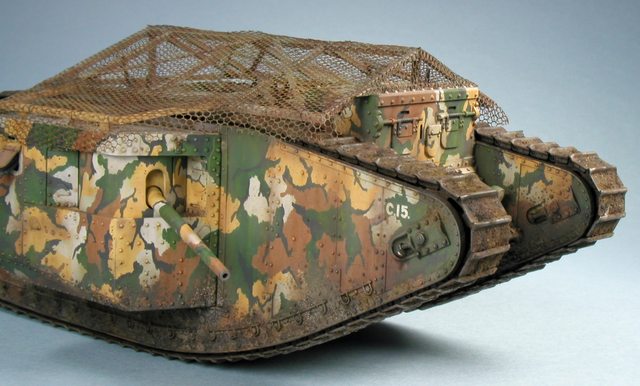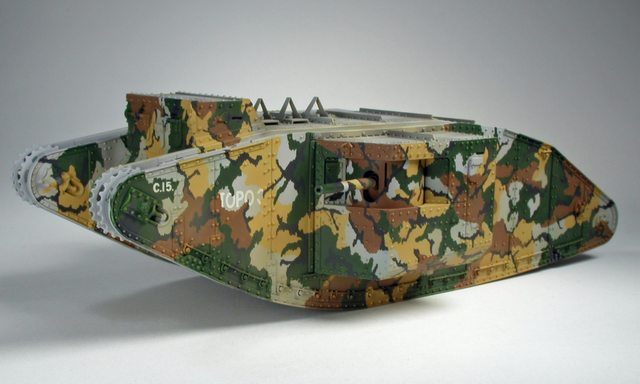I'm hoping someone can help me out. I am working on the Takom Mk1 Female kit and I have a question about the granade screens mounted to the roofs. I know they were made from wood frames with metal for the screens, but does anyone know if they were painted or just kept in their natural material state? Photos from WW1 are really hard to decipher as far as colors go.
Appreciate any help!
Thanks
Mike
Hosted by Darren Baker
Mk 1 Tank Grenade Screens

mmarchioli

Joined: March 18, 2008
KitMaker: 173 posts
Armorama: 168 posts

Posted: Sunday, April 08, 2018 - 09:17 AM UTC
Das_Abteilung

Joined: August 31, 2010
KitMaker: 365 posts
Armorama: 351 posts

Posted: Monday, April 09, 2018 - 04:15 AM UTC
According to Fletcher's books, only "some" tanks of A and C Companies were fitted with this roof screen. So if you want to use the screen on your model you're limited to those units.
As for colour, well who knows? In one photo of a camouflaged A Company tank the colour of the wood appears closer in tone to the ochre colour of the camouflage than the darker colours, suggesting unpainted wood.
I would be surprised if they were painted as they seem to have been produced in a hurry and in limited quantity. But I think it would be difficult for anyone to say you're wrong either way.
It's a shame no Mk1's were actually fitted with the original anti-grenade solution, a 4mm perforated applique plate raised 12" (300mm) above the normal roof. 25 sets were produced and some tanks were built or fitted with mounting studs for them, but none were ever fitted. The wood and wire frames were made as a quick alternative solution.
As for colour, well who knows? In one photo of a camouflaged A Company tank the colour of the wood appears closer in tone to the ochre colour of the camouflage than the darker colours, suggesting unpainted wood.
I would be surprised if they were painted as they seem to have been produced in a hurry and in limited quantity. But I think it would be difficult for anyone to say you're wrong either way.
It's a shame no Mk1's were actually fitted with the original anti-grenade solution, a 4mm perforated applique plate raised 12" (300mm) above the normal roof. 25 sets were produced and some tanks were built or fitted with mounting studs for them, but none were ever fitted. The wood and wire frames were made as a quick alternative solution.

Halbcl2

Joined: September 10, 2006
KitMaker: 127 posts
Armorama: 106 posts

Posted: Monday, April 09, 2018 - 04:23 AM UTC
Last year I spent considerable time researching the grenade screens/canopies, at least as best I could. I found no mention of whether they were painted or not. As they were batch made for Co 'C' and not mere individual "field" modifications, I considered it not unreasonable that they might have been painted. But it is just as likely that they were not. For visual interest I painted the main frame, but left the extensions over the sponsons in raw wood, as if they were an after thought. It really makes little difference for once you cover the frame with the chicken wire the colour is barely visible.


Das_Abteilung

Joined: August 31, 2010
KitMaker: 365 posts
Armorama: 351 posts

Posted: Monday, April 09, 2018 - 04:30 AM UTC
Nice.
I was about to dive in head-first and say that the wire mesh should surely be diamond-pattern. And I would have been very wrong.
For anyone else contemplating modelling this, I discovered that diamond-mesh chain link netting as we know it today wasn't invented until after WW1: 1928 IIRC. Wire mesh netting and the machine to weave it was invented in the UK in 1844 by Charles Barnard of Norwich. And that was indeed hexagonal mesh: what we today call chicken wire. As far as I can tell this is the type of wire mesh that would have been in production during WW1 and Barnards supplied several thousand miles of it during WW1. Don't know what gauge(s) of wire were used or size(s) of mesh were made. But hexagonal mesh would appear to be the correct choice for a Mk1 grenade screen.
I was about to dive in head-first and say that the wire mesh should surely be diamond-pattern. And I would have been very wrong.
For anyone else contemplating modelling this, I discovered that diamond-mesh chain link netting as we know it today wasn't invented until after WW1: 1928 IIRC. Wire mesh netting and the machine to weave it was invented in the UK in 1844 by Charles Barnard of Norwich. And that was indeed hexagonal mesh: what we today call chicken wire. As far as I can tell this is the type of wire mesh that would have been in production during WW1 and Barnards supplied several thousand miles of it during WW1. Don't know what gauge(s) of wire were used or size(s) of mesh were made. But hexagonal mesh would appear to be the correct choice for a Mk1 grenade screen.

sgtreef

Joined: March 01, 2002
KitMaker: 6,043 posts
Armorama: 4,347 posts

Posted: Monday, April 09, 2018 - 04:55 AM UTC
Quoted Text
Last year I spent considerable time researching the grenade screens/canopies, at least as best I could. I found no mention of whether they were painted or not. As they were batch made for Co 'C' and not mere individual "field" modifications, I considered it not unreasonable that they might have been painted. But it is just as likely that they were not. For visual interest I painted the main frame, but left the extensions over the sponsons in raw wood, as if they were an after thought. It really makes little difference for once you cover the frame with the chicken wire the colour is barely visible.
Nice camo work there, is that a pattern?
Or free handed?

Halbcl2

Joined: September 10, 2006
KitMaker: 127 posts
Armorama: 106 posts

Posted: Monday, April 09, 2018 - 07:01 AM UTC
Thanks! That was free handed - 25 hours of brush painting Vallejo acrylics to finish the basic five colour camo scheme . . . before weathering! The grey is just Tamiya's primer. The ochre, brown and green were each applied in multiple dilute coats, except for the black. A thin coat of ochre, then brown, then green and repeated until opaque. This made corrections much easier. Any brush marks disappeared with a spray of satin clear, preparatory to weathering.



mmarchioli

Joined: March 18, 2008
KitMaker: 173 posts
Armorama: 168 posts

Posted: Sunday, April 15, 2018 - 08:17 AM UTC
Thanks for the help guys!
I think I'll paint the frame, and fortunately I have some dio dump chicken wire which should fit the bill. Did you paint the frame gray Tom? Great looking tank BTW, thanks for sharing.
Mike
I think I'll paint the frame, and fortunately I have some dio dump chicken wire which should fit the bill. Did you paint the frame gray Tom? Great looking tank BTW, thanks for sharing.
Mike
 |






